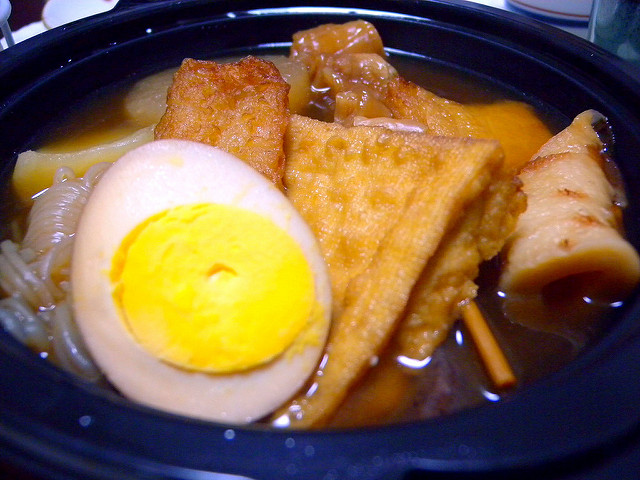Dec 14, 2016
Japan’s Winter Food
As a Brit, I am used to winters being cold, wet and miserable, with skies as grey as the faces shielded from the perpetual sleet and drizzle. As such, it always baffled me when Japanese friends would claim, without a second’s hesitation, that the year’s last was their favorite season.
Unsurprisingly, the reason behind this is the food. Hearty, healthy and warming, winter food in Japan is something that many Japanese look forward to all year round. This is just a quick look at what can be enjoyed in this coldest of seasons.
Nabe
Not being insulated, Japanese homes tend to get cold in winter, so one of the most popular dishes is one that the whole family can crowd around to keep warm. By far and away the most popular is the hot-pot dish ‘nabe’ or ‘nabemono’ (literally ‘things in a pot’). A nabe is actually a large cooking pot, into which a variety of ingredients such as fish, seafood, meats, and vegetables can be simmered in a ‘dashi’ or broth. The dish is cooked on a gas stove around which the family can gather, taking from the bowl and adding more as they go. There are various kinds of nabe such as motsunabe that uses beef or pork with cabbage and chives, kimchinabe that utilizes the Korean spicy fermented cabbage, or yosenabe with meat, seafood, vegetables, tofu, and egg.
Shabu-shabu/Sukiyaki
Like the nabe, shabu-shabu, my favorite winter dish, is prepared on a gas stove in a large pot and has ingredients such as vegetables, seafood and, most commonly, pork strips. Unlike the nabe dishes, with shabu-shabu each item is cooked individually by stirring it through the boiling water or dashi, and it is from this action that the dish gains its onomatopoeic name as you swish it one way (shabu) and then the next (shabu). The cooked ingredients are then dipped into a vinegar ponzu.
Sukiyaki is a near identical dish, though the broth is a sweeter mixture of soy sauce, sugar, and mirin, and ingredients are dipped in raw egg rather than ponzu.
Oden
Another warming dish, oden (in the main picture above) is a huge winter favourite. You may have noticed it in the convenience stores in the big wooden pots near the cashier. If you are anything like me, then you will have noticed the smell before you saw it and been a little revolted (the strong fishy scent is a turn off for me), but ask any Japanese, the conbini oden is not a patch on the real stuff. Often sold by street vendors this dish features a variety of ingredients, such as egg, tofu, konnyaku yam cake, daikon radish, and chikawa fishcake which are stewed for hours in a soy sauce based broth.
Yakiimo
Yakiimo is, as the name suggests, baked potato. However this is no ordinary baked potato, but rather the super sweet, purple on the outside, yellow on the inside, Japanese potato. To an older generation, there is nothing to signal the coming of winter quite like the plaintive call of the yakiimo seller, wheeling his cart, singing his arrival “yakiimo, ishi yakiimo”. Nowadays you are most likely to find yakiimo at festivals or at vendors outside supermarkets but you may still find them sold from the back of vans where they wrapped in newspaper to be devoured: creamy, sweet and a true taste of traditional Japanese winter.

Yakiimo, a Japanese baked potato cooking in foil.
Nikuman
There is a good chance that you have seen the Game of Thrones memes going around. A character stares out into the middle distance surrounded by the caption ‘The conbinis are selling nikuman.’ Yes, nothing quite denotes the coming of winter in Japan like convenience stores returning the nikiman to their glass steam cabinets. Nikuman, the Japanese take on the chinese food ‘baozi’, is a steamed flour dough filled with juicy meat (though there are other flavors such as ‘curryman’ and ‘pizzaman’, the latter of which isn’t as awful as it sounds. With the traditional nikuman, I can recommend using a small pinch of mustard. Well worth the funny looks you’ll get!
Fugu
This last one isn’t exactly a dish that one immediately thinks of in winter, however it is something of a seasonal treat that is best tried at this time of year. Fugu, or blowfish, is famous in the west for being a deadly delicacy, but handled correctly (by chefs that have gone through many years of training), and keeping away from the poisonous liver, it is a delicious dish. In winter there are many places at which you can enjoy a full course, starting with fugu sashimi, deep fried fugu ‘karaage’ and finally, as it is winter after all, fugu nabe. I highly recommend overcoming your fears and searching it out, as it is absolutely delicious. But as I say, ensure that you are dining at a reputable, licensed restaurant. Do not try this at home!
Mark Guthrie
Image by 5th Luna (Own work) [CC BY-SA 2.0], via flickr.com (modified)
Image by calltheambulance (Own work) [CC BY-SA 2.0], via flickr.com (modified)
Image by Jeff (Own work) [CC BY-SA 2.0], via flickr.com (modified)
Image by popopopo (Own work) [CC BY-SA 2.0], via flickr.com (modified)
Image by Lachlan Hardy (Own work) [CC BY-SA 2.0], via flickr.com (modified)
Image by Madalina Seghete (Own work) [CC BY-SA 2.0], via flickr.com (modified)







About the author